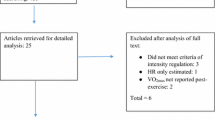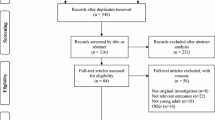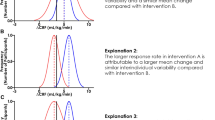Summary
This review has grouped many studies on different populations with different protocols to show the interactive effects of intensity, frequency and duration of training as well as the effects of initial fitness levels and programme length on cardiorespiratory fitness as reflected by aerobic power (V̇O2max). Within each level of exercise duration, frequency, programme length or initial fitness level, the greatest improvements in aerobic power occur when the greatest challenge to aerobic power occurs i.e., when intensity is from 90 to 100% of V̇O2max. The pattern of improvement where different intensities are compared with different durations suggests that when exercise exceeds 35 minutes, a lower intensity of training results in the same effect as those achieved at higher intensities for shorter durations. Frequencies of as low as 2 per week can result in improvements in less fit subjects but when aerobic power exceeds 50 ml/kg/min, exercise frequency of at least 3 times per week is required. As the levels of initial fitness improve, the change in aerobic power decreases regardless of the intensity, frequency or duration of exercise.
Although these pooled data suggest that maximal gains in aerobic power are elicited with intensities between 90 to 100% V̇O2 max, 4 times per week with exercise durations of 35 to 45 minutes, it is important to note that lower intensities still produce effective changes and reduce the risks of injury in non-athletic groups.
Similar content being viewed by others
References
Anderson P, Henriksson J. Capillary supply of the quadraceps femoris muscle of man: adaptive response to exercise. Journal of Physiology 270: 677–690, 1977
Atomi Y, Miyashita M. Effect of training intensity in adult females on aerobic power, related to lean body mass. European Journal of Applied Physiology 44: 109–116, 1980
Becher DM, Vaccaro P. Anaerobic threshold alterations caused by endurance training in young children. Journal of Sports Medicine 23: 445–449, 1983
Bhambani Y, Singh M. The effects of three training intensities on VO2max and Ve/VO2 ratio. Canadian Journal of Applied Sport Sciences 10(1): 44–51, 1985
Bryntson P, Sinning WE. The effects of training frequencies on the retention of cardiovascular fitness. Medicine and Science in Sports 5: 29–33, 1973
Burke EJ, Franks DE. Changes in VO2 max resulting from bicycle training at different intensities holding mechanical work constant. Research Quarterly 46: 31–37, 1975
Cunningham DA, McCrimmon D, Vlach LF. Cardiovascular response to interval and continuous training in women. European Journal of Applied Physiology 41: 187–197, 1979
Davis JA, Frank MH, Whipp BJ, Wasserman K. Anaerobic threshold alterations caused by endurance training in middleaged men. Journal of Applied Physiology 46: 1039–1046, 1979
Davies CTM, Knibbs AV. The training stimulus: the effects of intensity of effort on maximum aerobic power output. Internationale Zeitschrift fur Angewandte Physiologie Einschliesslich Arbeits Physiologie 29: 299–305, 1971
Demeersam RE, Schiltz JH. Decreased training frequency and pulmonary function retention in the female athlete. Journal of Sports Medicine and Physical Fitness 24(2): 155–158, 1984
Dudley GA, Abraham WM, Terjung RL. Influence of exercise intensity and duration on biochemical adaptations in skeletal muscle. Journal of Applied Physiology 53: 844–850, 1982
Eddy DA, Sparks KL, Adelize DA. The effects of continuous and interval training on women and men. European Journal of Applied Physiology 37: 83–92, 1977
Faria I._Cardiovascular response to exercise as influenced by training at various intensities. Research Quarterly 41: 44–49, 1970
Fitts RH, Booth FW, Winder WW, Holloszy JO. Skeletal muscle respiratory capacity, endurance, and glycogen utilization. American Journal of Physiology 228: 1029–1033, 1975
Fox EL, Bartels RL, Billings CE, Mathews DK, Bason R, et al. Intensity and distance of interval training programs and changes in aerobic power. Medicine and Science in Sports 5: 18–22, 1973
Fox EL, Bartels RL, Billings CE, O’Brien R, Bason R, et al. Frequency and duration of interval programs and changes in aerobic power. Journal of Applied Physiology 38: 481–484, 1975
Fox EL, Bartels RL, Klinzing J, Ragg K. Metabolic responses to interval training programs of high and low power outputs. Medicine and Science in Sports 9: 191–196, 1977
Fox EL, Mathews DK. The physiological basis of physical education and athletics, 3rd ed, Saunders College Publishing, Philadelphia, 1981
Fringer MN, Stull GA. Changes in cardiorespiratory parameters during periods of training and detraining in young adult females. Medicine and Science in Sports 6: 20–25, 1974
Gaesser GA, Rich RG. Effects of high and low intensity training on aerobic capacity and blood lipids. Medicine and Science in Sports and Exercise 16(3): 269–274, 1984
Gettman LR, Pollock ML, Dursting JL, Ward A, Ayres J, Linnerud AC. Physiological response of men to 1, 3 and 5 day per week training programs. Research Quarterly 47: 638–646, 1977
Gibbons ES, Jessup GT, Wells TD, Worthmann DA. Effects of various training intensity levels on anaerobic threshold and aerobic capacity in females. Journal of Sports Medicine and Physical Fitness 23(3): 315–318, 1983
Golden HP, Vaccaro P. The effects of endurance training on the anaerobic threshold. Journal of Sports Medicine and Physical Fitness 24: 205–211, 1984
Gollnick P, Piehl K, Karlsson J, Saltin B. Glycogen depletion patterns in human skeletal muscle fibers after varying types and intensities of exercise. In Howald and Poortmans (Eds) Metabolic adaptation to prolonged exercise, pp. 416–421, Basel Birkhauser, Verlag, 1975
Gregory LW. The development of aerobic capacity: a comparison of continuous and interval training. Research Quarterly 50: 199–206, 1979
Hagberg JM, Ehsani AA, Holloszy JO. Effect of 12 months of intense exercise training on stroke volume in patients with coronary artery disease. Circulation 67: 1194–1199, 1983
Harms SJ, Hickson RC. Skeletal muscle mitochondria and myoglobin, endurance, and intensity of training. Journal of Applied Physiology 54: 798–802, 1983
Henritze J, Weltman A, Schurrer RL, Barlow K. Effects of training at and above the lactate threshold and maximal oxygen uptake. European Journal of Applied Physiology 54: 84–88, 1985
Hickson RC, Bomze HA, Holloszy JO. Linear increase in aerobic power induced by a strenuous program of endurance exercise. Journal of Applied Physiology 42: 372–376, 1977
Hickson RC, Foster C, Pollock ML, Galassi TM, Rich S. Reduced training intensities and loss of aerobic power, endurance, and cardiac growth. Journal of Applied Physiology 58(2): 492–499, 1985
Hickson RC, Hagberg JM, Ehsani AA, Holloszy JO. Time course of the adaptive responses of aerobic power and heart rate to training. Medicine and Science in Sports and Exercise 13: 17–20, 1981b
Hickson RC, Kanakis CJR, Moore AM, Rich S. Effects of training, reduced training, and retraining on aerobic power and left ventricular responses (Abstract). Medicine and Science in Sports 13: 93, 1981a
Hickson RC, Overland SM, Dougherty KA. Reduced training frequency effects on aerobic power and muscle adaptations in rats. Journal of Applied Physiology 57(6): 1834–1841, 1984
Hickson RC, Rosenkoetter M. Reduced training frequencies and maintenance of increased aerobic power. Medicine and Science in Sports 13: 13–16, 1981b
Hickson RC, Rosenkoetter MA, Brown MM. Strength training effects on aerobic power and short-term endurance. Medicine and Science in Sports 12: 336–339, 1980
Holloszy JO, Coyle EF. Adaptations of skeletal muscle to endurance exercise and their metabolic consequences. Journal of Applied Physiology 56(4): 831–838, 1984
Hoppeler H, Howald H, Conley K, Lindstedt L, Ciaassen H, et al. Endurance training in humans: aerobic capacity and structure of skeletal muscle. Journal of Applied Physiology 59(2): 320–327, 1985
Hurley BF, Seals DR, Ehsani AA, Cartier LJ, Dalsky GP, et al. Effects of high-intensity strength training on cardiovascular function. Medicine and Science in Sports 16(5): 483–488, 1984
Jackson JH, Sharkey BJ, Johnson PL. Cardio-respiratory adaptations to training at specified frequencies. Research Quarterly 39: 295–300, 1968
Johnson S, Berg K, Latin R. The effect of training of aerobic dance on oxygen uptake, body composition and personality. Journal of Sports Medicine and Physical Fitness 24: 290–295, 1984
Katch V, Weltman A, Sady S, Freedson P. Validity of the relative percent concept for equating training intensities. European Journal of Applied Physiology 39: 219–227, 1978
Kilbom A. Physical training in women. Journal of Clinical Laboratory Investigation (Suppl. 119): 13–18, 1971
Knuttgen HG, Nordesjo LO, Orlander B, Saltin B. Physical conditioning through interval training with young male adults. Medicine and Science in Sports 5: 220–226, 1973
Lavoie NF. The aerobic cost of exercise as a determinant of endurance fitness. Canadian Journal of Applied Sport Sciences 2: 121–125, 1977
Lesmes GR, Fox EL, Stevens C, Otto R. Metabolic responses to high intensity interval training of different frequencies. Medicine and Science in Sports 10(4): 229–232, 1978
MacDougall D, Sale D. Continuous vs. interval training: a review for the athlete and coach. Canadian Journal of Applied Sport Sciences 6(2): 93–97, 1981
MacDougall JD, Wenger HA, Green HJ (Eds). Physiological testing of the elite athlete. Mutual Press, Ottawa, 1982
Magle JR, Foglia GF, McArdle WD, Gutin B, Pechar GS, Katch FI. Specificity of swim training on maximal oxygen uptake. Journal of Applied Physiology 38: 151–155, 1975
Massicotte D, MacNab RBJ. Cardiorespiratory adaptations to training at specified intensities in children. Medicine and Science in Sports 6: 242–246, 1974
McArdle WD, Magle JR, Dilio DJ, Toner M, Chase JM. Specificity of run training on VO2 max and heart rate changes during running and swimming. Medicine and Science in Sports 10: 16–20, 1978
McLellan TM, Skinner JS. The use of the aerobic threshold as a basis for training. Canadian Journal of Applied Sports Sciences 6: 197–201, 1981
Mikesell KA, Dudley GA. Influence of intense endurance training on aerobic power of competitive distance runners. Medicine and Science in Sports and Exercise 16(4): 371–375, 1984
Milesis CA, Pollock ML, Bah MD, Ayres JJ, Ward A, et al. Effects of different durations of physical training on cardiorespiratory function, body composition, and serum lipids. Research Quarterly 47: 716–725, 1976
Moffatt RJ, Stamford BA, Neill RD. Placement of triweekly training sessions: importance regarding enhancement of aerobic capacity. Research Quarterly 48(3): 583–591, 1977
Orlander J, Kiessling KH, Karlsson J, Ekblom B. Low intensity training, inactivity and resumed training in sedentary men. Acta Physiologica Scandinavica 101: 351–362, 1977
Pechar GS, McArdle WD, Katch FI, Magel JR, DeLuca J. Specificity of cardio-respiratory adaptation to bicycle and treadmill training. Journal of Applied Physiology 36: 753–756, 1974
Pollock ML. The quantification of endurance training programs. Exercise and Sport Science Reviews 1: 158–188, 1973
Pollock ML, Broida J, Kendrick Z, Miller Jr HS, Janeway R, et al. Effects of training two days per week at different intensities on middle-aged men. Medicine and Science in Sports 4: 6–10, 1972
Pollock ML, Cureton TK, Greniger MS. Effects of frequency of training on working capacity, C.V. function and body composition of adult men. Medicine and Science in Sports 1: 70–74, 1969
Pollock ML, Dimmick J, Miller Jr HS, Kendrick Z, Linnerud AC. Effects of mode of training on cardiovascular function and body composition of middle-aged men. Medicine and Science in Sports 7(2): 139–145, 1975a
Pollock ML, Miller HS, Linnerud AC, Cooper KH. Frequency of training as a determinant for improvement in cardiovascular function and body composition of middle-aged men. Archives of Physiology and Medical Rehabilitation 56: 141–145, 1975b
Poole DC, Gaesser GA. Effects of continuous and interval training on lactate threshold and maximal aerobic capacity. Medicine and Science in Sports and Exercise 16(2): 183–188, 1984
Poole DC, Gaesser GA. Response of ventilatory and lactate thresholds to continuous and interval training. Journal of Applied Physiology 58(4): 1115–1121, 1985
Prud’Homme D, Bouchard C, Liblanc C, Landry F, Fontaine E. Sensitivity of maximal aerobic power to training is genotype dependent. Medicine and Science in Sports and Exercise 16(5): 489–493, 1984
Ready AE, Quinney HA. Alterations in aerobic threshold as a result of the endurance training and detraining. Medicine and Science in Sports and Exercise 14(4): 292–296, 1982
Sady S, Katch V, Freedson P, Weltman A. Changes in metabolic acidosis: evidence for an intensity threshold. Journal of Sports Medicine 20: 41–46, 1980
Saltin B, Hartley LH, Kilbom A, Astrand I. Physical training in sedentary men. Scandinavian Journal of Clinical Laboratory Investigation 24: 323–324, 1969
Seals DR, Hagberg JM, Hurley BF, Ehsani AA, Holloszy JO. Endurance training in older men and women. Journal of Applied Physiology 57(4): 1024–1033, 1984
Sharkey BJ. Intensity and duration of training and the development of cardio-respiratory endurance. Medicine and Science in Sports 2: 197–202, 1970
Sharkey BJ, Holleman JP. Cardio-respiratory adaptations to training at specified intensities. Research Quarterly 38: 698–704, 1967
Shephard RJ. Intensity, duration and frequency of exercise as determinants of the response to a training regime. Internationale Zeitschrift fur Angewante Physiologie Einschliesslich Arbeits Physiologie 26: 272–278, 1968
Smith DJ, Wenger HA. The 10 day aerobic mini cycle: the effects of interval or continuous training at two different intensities. Journal of Sports Medicine and Physical Fitness 21(4): 390–394, 1981
Terjung RL. Muscle fiber involvement during training of different intensities and duration. American Journal of Physiology 230(4): 946–950, 1976
Thomas TR, Adeniran SB, Etheridge GL. Effects of different running programs on VO2 max, percent body fat, and plasma lipids. Canadian Journal of Applied Sport Sciences 9(2): 55–62, 1984
Thomas TR, Adeniran SB, Iltis PW, Aquiar CA, Albers JJ. Effects of interval and continuous running in HDL-Cholesterol, Apoproteins A-1 and B, and LCAT. Canadian Journal of Applied Sport Sciences 10(1): 52–59, 1985
Wenger HA, MacNab RBJ. Endurance training: the effects of intensity, total work, duration and initial fitness. Journal of Sports Medicine and Physical Fitness 15(3): 199–211, 1975
Wilcox AR, Bulbulian R. Changes in running economy relative to VO2 max during a cross-country season. Journal of Sports Medicine 24: 321–327, 1984
Wilmore JH, Davies JA, O’Brien RS, Vodak PA, Wlader GR, et al. Physiological alterations consequent to twenty-week conditioning programs of bicycling, tennis and jogging. Medicine and Science in Sports 12: 1–8, 1980
Author information
Authors and Affiliations
Rights and permissions
About this article
Cite this article
Wenger, H.A., Bell, G.J. The Interactions of Intensity, Frequency and Duration of Exercise Training in Altering Cardiorespiratory Fitness. Sports Medicine 3, 346–356 (1986). https://doi.org/10.2165/00007256-198603050-00004
Published:
Issue Date:
DOI: https://doi.org/10.2165/00007256-198603050-00004




